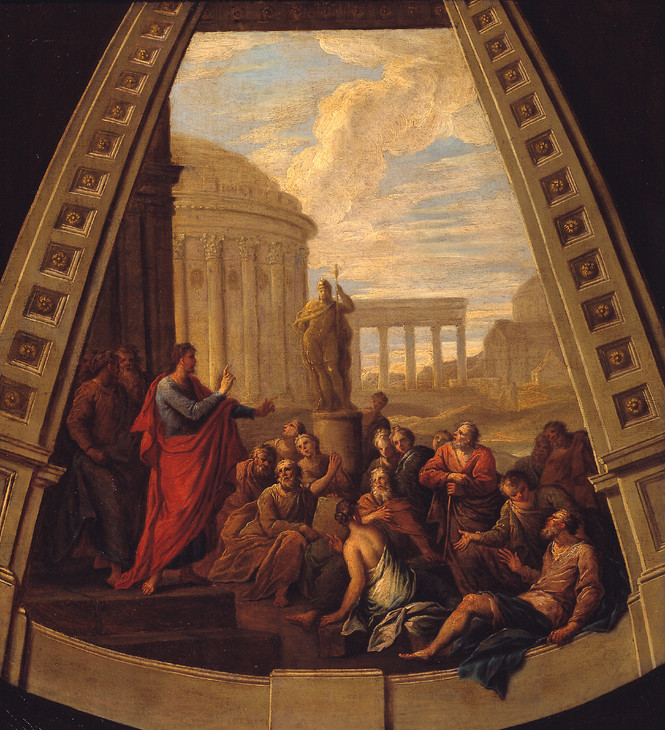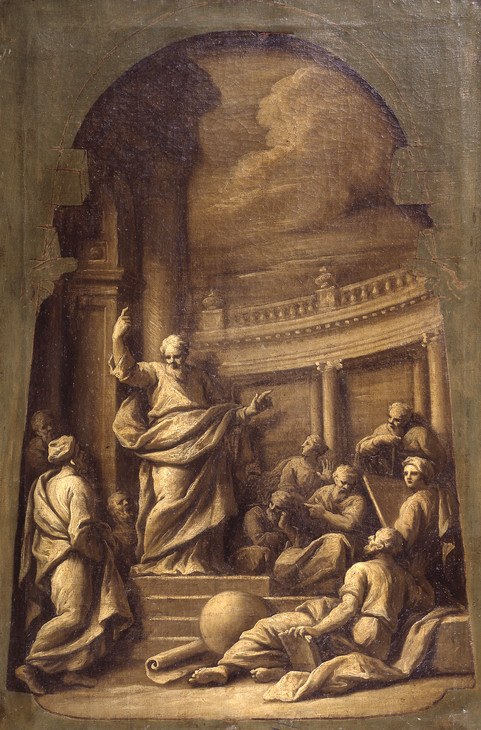Sublime Rhetoric: Two versions of St Paul Preaching at Athens by James Thornhill
Lydia Hamlett
The work of the classical author known as the Pseudo-Longinus Peri Hypsous (translated into English as ‘On Height’) was first published in book form in Basel, Switzerland, in 1554 and in Britain in 1636. It was intended to be an instruction manual on the power of words, and especially on rhetoric, or public speaking. The author attempted to describe the most effective way of conveying a message to an audience, with the aim of moving and persuading them. This could be achieved in various ways, including through vocabulary, sentence structure and subject matter. The most important thing, however, was the effect on the listener. The author said that everyone has the potential to learn how to create the sublime and also to be affected by it.
The author is often known as the Pseudo-Longinus because today there are doubts about his identity. In the eighteenth century the text was more certainly associated with a First Cetury writer, Longinus. In the introduction and footnotes to his translation of Peri Hypsous (as On the Sublime, 1739), the Reverend William Smith makes much of what were thought to be Longinus’s connections with early Christianity and also attempts to connect the ancient sublime with religious morality and contemporary social issues. Significantly, as we shall see, Smith compared Longinus and St Paul, the dedicatee of London’s recently restored cathedral. Both men spent time in Athens, where Longinus was said to have published Peri Hypsous and where St Paul preached Christianity to the local people. They were both ‘sublime’ characters, with a commanding and persuasive presence. This judgement was not unusual, as it was thought at the time that people could embody the sublime: that there were heroes who could, in turn, encourage others to be improved morally. Pseudo-Longinus described how the behaviour or language of a person could make them sublime, giving examples such as the mythical hero Ajax. In the early eighteenth century the poet Alexander Pope said that Longinus himself was an example of the great sublime that he described:
Thee, bold Longinus! all the Nine inspire,
And bless their critic with a poet’s fire.
An ardent judge, who zealous in his trust,
With warmth gives sentence, yet is always just;
Whose own example strengthens all his laws,
And is himself that great sublime he draws.1
And bless their critic with a poet’s fire.
An ardent judge, who zealous in his trust,
With warmth gives sentence, yet is always just;
Whose own example strengthens all his laws,
And is himself that great sublime he draws.1
Around the same time the popularity of St Paul as the British patron saint was gathering force, and he was frequently written about as a sublime character – as close to God as man could be – who preached effectively to convert others. Pictures of the saint were also thought to convey his sublimity.
Both St Paul and Longinus were depicted preaching to Athenians in various works of visual art of the time, and some of these images are very similar to each other. In the artist Louis Chéron’s frontispiece to an edition of Peri Hypsous of 1724, Longinus is shown lecturing to the Athenians indoors. However, in the frontispiece to Smith’s 1739 edition a figure is shown outdoors,2 in a pose very similar to that of St Paul preaching to the Athenians in a sixteenth-century design by the artist Raphael. It is likely that this figure is intended to represent Longinus but he is shown in the widely recognised pose of St Paul. This suggests a very deliberate comparison between the two historical figures.
The reigns of William III and Mary (1689–1702) followed by Queen Anne (1702–1714) witnessed major rebuilding and decoration programmes in London, including the ceiling of the Painted Hall at Greenwich and the interior of the dome at St Paul’s Cathedral. Both commissions were taken up by the artist James Thornhill. The former glorified William and Mary in the exuberant and full polychrome of the style later termed the ‘Baroque’, while the latter was in more sober monochrome and depicted scenes from the life of St Paul. In both commissions Thornhill included the episode of St Paul preaching to a crowd of Athenians, who are visibly affected by his words. Thornhill was clearly influenced by Raphael’s Sistine Chapel tapestries, cartoons of which had entered the British Royal Collection, including a design that featured St Paul3. The cartoons were described by British writers including Jonathan Richardson – a friend of Thornhill – to be the most sublime examples of art.

Sir James Thornhill 1675 or 76–1734
St Paul Preaching at Athens c.1710
Oil paint on canvas
support: 820 x 737 mm
Lent by the Dean and Chapter of St Pauls Cathedral 1989
On long-term loan to Tate L01480
On long-term loan to Tate L01480
Fig.1
Sir James Thornhill
St Paul Preaching at Athens c.1710
Lent by the Dean and Chapter of St Pauls Cathedral 1989
On long-term loan to Tate L01480
On long-term loan to Tate L01480

Sir James Thornhill 1675 or 76–1734
St Paul Preaching at Athens c.1720
Oil paint on canvas
support: 767 x 512 x 18 mm; frame: 825 x 565 x 26 mm
Lent by the Dean and Chapter of St Pauls Cathedral 1989
On long-term loan to Tate L01486
On long-term loan to Tate L01486
Fig.2
Sir James Thornhill
St Paul Preaching at Athens c.1720
Lent by the Dean and Chapter of St Pauls Cathedral 1989
On long-term loan to Tate L01486
On long-term loan to Tate L01486
The preparatory sketches for Thornhill’s dome of St Paul’s are currently on loan to Tate. In the sketch dated to around 1710 the figure to the far right of the crowd appears to be thrown back, his garments falling out of the illusionistic architectural frame onto which his hand clutches (L01480, fig.1). This is a depiction of people being visibly affected by the force of the saint’s words, more so perhaps than in Raphael’s original design. The later sketch (dated to around 1720) has a more reduced composition, with fewer figures and a stronger contrast of black and white (L01486, fig.2). The chiaroscuro effects – the strong contrast between dark and light shades – were essential in creating an impact on the spectator viewing them from the ground below and are quite different from Raphael’s muted colours.
Thornhill’s monochrome use of colour was intended to suggest the sublime in its simplicity. Pseudo-Longinus wrote in Peri Hypsous that the most effective, and therefore most sublime, speech was simple. At this time Thornhill’s friend Richardson was applying Pseudo-Longinus’s thoughts on rhetoric to painting, arguing that sublime simplicity could be found in the visual arts. As an example of sublime simplicity, in An Essay on the Theory of Painting (1725) Richardson chose a Rembrandt sketch of a dying man and his son praying to God, which was humble in its subject as well as the manner in which it was executed, that is, as a simple monochrome sketch. This did not discount that colour could also be sublime, as Richardson said it could be when in the hands of a master like Titian.
The way in which Thornhill painted the dome relies on light as its central effect. Its impact lies in the stark simplicity of its monochrome chiaroscuro rather than on the abundance of form or colour. In each of the eight scenes that illustrate the life of the cathedral’s dedicated saint the illusionistic light comes from the top left, casting shadows in the arches by which each is framed and on the urns which decorate the base of each pier. In place of an apotheosis or assembly of heavenly creatures in the centre, which was typical, our eyes are raised upwards into the oculus of an illusionistic coffered vault and then into the real skylight at the very top. By presenting the earthly acts of St Paul in a simple yet visually affecting way, and juxtaposing them with a central source of real, ‘divine’ light, the dome appears to answer the central question that the Reverend Smith identifies in Pseudo-Longinus: ‘when do we most resemble the [Christian] God?’.
It was important for the organisers of the dome commission that a British Protestant artist was eventually employed; as a result, Thornhill overcame competition from many others including French and Venetian artists. Perhaps it was only at St Paul’s that the Protestants found a justifiable type of decorative history painting to rival the grand-scale Catholic Baroque visions on the continent.
Notes
Reproduced in William Smith (ed.), Dionysius Longinus on the Sublime: Translated from the Greek, with Notes and Observations, and Some Account of the Life, Writings, and Character of the Author, third edn, London 1752, http://www.archive.org/stream/dionysiuslongin00smitgoog#page/n8/mode/2up , accessed 8 June 2011.
See http://www.royalcollection.org.uk/eGallery/object.asp?recent=Y&object=912950&row=616 , accessed 13 September 2012.
Lydia Hamlett is Research Assistant (The Sublime Object: Nature, Art and Language), Tate.
How to cite
Lydia Hamlett, ‘Sublime Rhetoric: Two versions of St Paul Preaching at Athens by James Thornhill’, in Nigel Llewellyn and Christine Riding (eds.), The Art of the Sublime, Tate Research Publication, January 2013, https://www
